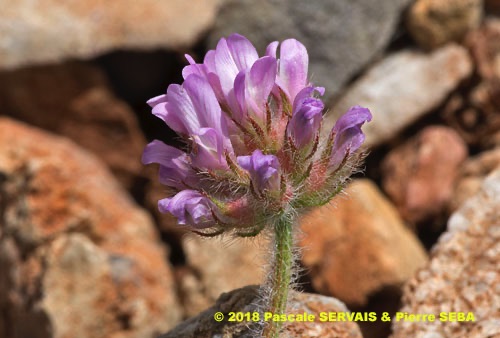
Astragalus echinatus Murray
Fam. : Fabaceae
© Pascale SERVAIS & Pierre SEBA, 2018. Tilo Botanica: Flore de Tilos et du Dodécanèse / Flora of Tilos and of the Dodecanese
English translation by Brenda Bradbury, Howard Bradbury and Stéphane Léonard
Plante herbacée, hermaphrodite, à tiges étalées ou retombantes, poilues.
Feuilles alternes, composées imparipennées, de 4 à 8 cm de long, à 13 à 21 folioles, oblongues, échancrées ou tronquées au sommet, glabres dessus, un peu poilues dessous. Stipules non soudées au pétiole.
Fleurs à symétrie bilatérale, mauves, lilas ou pourpres, de 8 à 12 mm de long, réunies par 9 à 15 en grappes denses portées par un pédoncule égal ou plus long que la feuille sous-jacente. Corolle papilionacée. Calice à 5 sépales poilus soudés sur la moitié de leur longueur. 9 étamines soudées entre elles et 1 libre. Ovaire supère.
Fruits, gousses dressées, ovales-triangulaires, aplaties, de 10 à 15 mm de long et 3 à 7 mm de large, pubescentes, couvertes de soies et d’écailles, à bec crochu.
___________________________
Plant herbaceous, hermaphrodite. Stems spread out or falling down, hairy.
Leaves alternate, compound imparipinnate, from 4 to 8 cm long, with 13 to 21 leaflets, oblong, indented or truncate at the top, glabrous on the upper surface, a little hairy on the lower surface. Stipules nonfused with the petiole.
Flowers bilaterally symmetrical, mauve, lilac or purple, from 8 to 12 mm long, joined together by 9 to 15 in dense racemes carried by a peduncle equal to or longer than the underlying leaf. Corolla papilionaceous. Calyx with 5 hairy sepals fused on half their length. 9 stamens fused with each other and 1 free. Ovary superior.
Fruits, erect pods, ovate-triangular, flattened, from 10 to 15 mm long and 3 to 7 mm across, pubescent, covered in bristles and scales, with a hooked beak.
Descripteurs / Identifying features
1
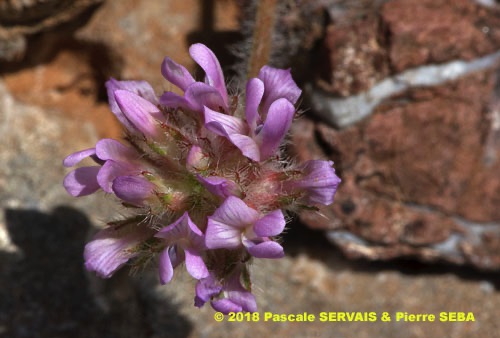
2
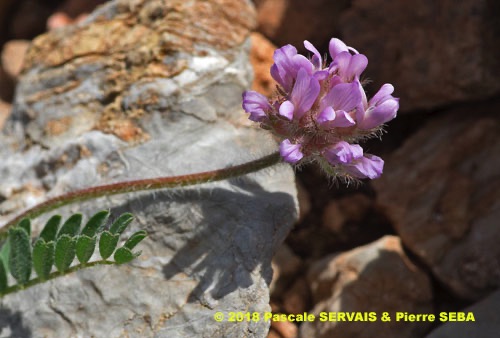
3
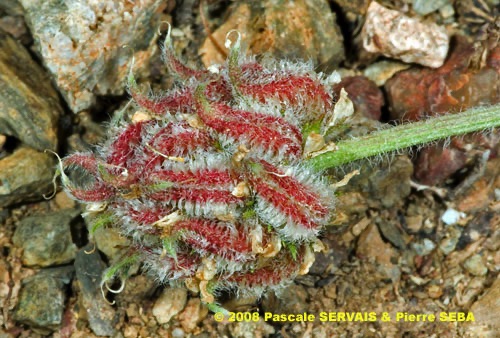
4
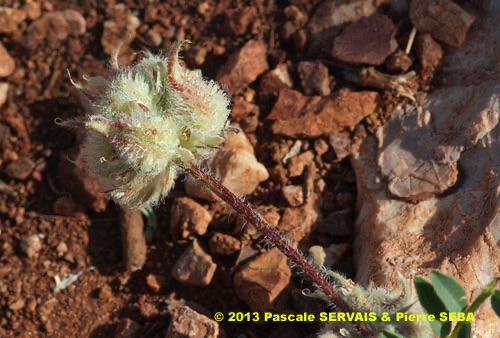
5
Étymologie / Etymology :
Astragalus : emprunt du latin astragalus, -i (nom) = l’astragale, nom
donné au pois chiche par Pline, naturaliste latin mort en 79 apr. J.-C.,
forme latinisée du grec ancien ἀστράγαλος, -ου (nom) = la vertèbre,
l’osselet, nom donné à la plante par Dioscoride, médecin et botaniste
grec mort en 90 apr. J.-C., en référence à la forme des graines
semblables à des osselets.
Echinatus : emprunt du latin echinatus, -a, -um (adj.)
[ < echinus, -i (nom) = le hérisson, l’oursin ], forme latinisée du grec
ancien ἐχῖνος, -ου (nom) = le hérisson, l’oursin, en référence aux
fruits hérissés de piquants.
Astragalus : borrowed from Latin astragalus, -i (noun) = astragalus,
name given to chick-pea by Plinius, Latin naturalist died in 79 AD,
Latinized form of the Classical Greek ἀστράγαλος, -ου (noun)
= vertebra, ossicle, name given to the plant by Dioscorides,
Greek doctor and botanist died in 90 AD, referring to the shape of
seeds similar to ossicles.
Echinatus : borrowed from Latin echinatus, -a, -um (adj)
[ < echinus, -i (noun) = hedgehog, sea urchin ], Latinized form
of the Classical Greek ἐχῖνος, -ου (noun) = hedgehog, sea urchin,
referring to the fruits covered in thorns.
Synonymes / Synonyms :
Astragalus cristatus Gouan
Astragalus pentaglottis L.
Astragalus stenorrhinus Pau
Glottis echinata (Murray) Medik.
Glottis pentaglottis (L.) Medik.
Noms vernaculaires / Common names :
Noms français / French names :
Astragale hérissé — Astragale hérissé d’aiguillons.
Nom anglais / English name :
Hedgehog milkvetch.
Nom allemand / German name :
Igel-Tragant.
Nom italien / Italian name :
Astragalo echinato.
Habitat :
Cultures - Lieux incultes - Sols sableux - Chemins.
Cultivated places - Waste ground - Sandy soils - Waysides.
Île / Island :
Tilos.
Hauteur / Height range :
De 10 cm à 30 cm.
From 10 cm to 30 cm.
Floraison / Flowering time :
De mars à mai.
From March to May.
Groupe / Classification :
Dicotylédones.
Dicotyledons.
Pérennité / Lifespan :
Annuelle.
Annual.
Description :
Clés dichotomiques et descripteurs distinctifs des 4 espèces / Dichotomous keys and distinctive identifying features of the 4 species
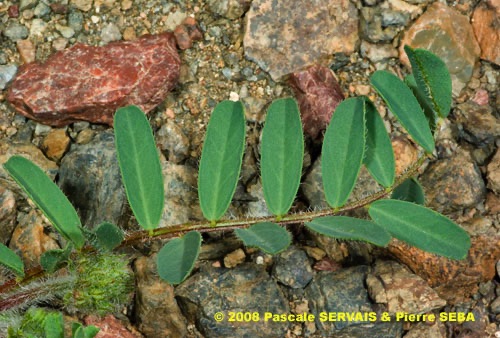
6
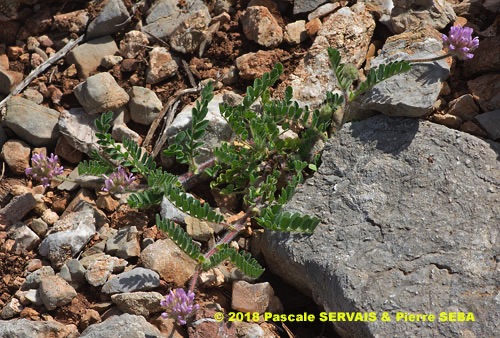
7
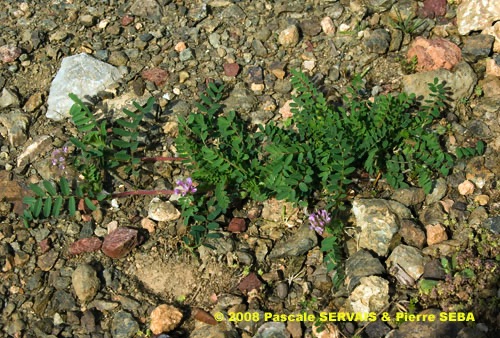
8
Photo 1 :
Localisation / Location : Tilos, Livadia, Environs
Date : 18/04/2018
GPS : Lat. 36,42048° N / Long. 27,38211° E / Alt. 168 m
Type : Photographie numérique / Digital Photograph (24 mégapixels)
Photo 2 :
Localisation / Location : Tilos, Livadia, Environs
Date : 18/04/2018
GPS : Lat. 36,42048° N / Long. 27,38211° E / Alt. 168 m
Type : Photographie numérique / Digital Photograph (24 mégapixels)
Photo 3 :
Localisation / Location : Tilos, Livadia, Environs
Date : 18/04/2018
GPS : Lat. 36,42048° N / Long. 27,38211° E / Alt. 168 m
Type : Photographie numérique / Digital Photograph (24 mégapixels)
Photo 4 :
Localisation / Location : Tilos, Megalochorio, Plaka
Date : 15/04/2008
GPS : Lat. 36,46375° N / Long. 27,30546° E / Alt. 38 m
Type : Photographie numérique / Digital Photograph (10 mégapixels)
Photo 5 :
Localisation / Location : Tilos, Livadia, Chemin de Lethra
Date : 06/05/2013
GPS : Lat. 36,43448° N / Long. 27,38612° E / Alt. 62 m
Type : Photographie numérique / Digital Photograph (10 mégapixels)
Photo 6 :
Localisation / Location : Tilos, Megalochorio, Plaka
Date : 15/04/2008
GPS : Lat. 36,46375° N / Long. 27,30546° E / Alt. 38 m
Type : Photographie numérique / Digital Photograph (10 mégapixels)
Photo 7 :
Localisation / Location : Tilos, Livadia, Environs
Date : 18/04/2018
GPS : Lat. 36,42048° N / Long. 27,38211° E / Alt. 168 m
Type : Photographie numérique / Digital Photograph (24 mégapixels)
Photo 8 :
Localisation / Location : Tilos, Megalochorio, Plaka
Date : 15/04/2008
GPS : Lat. 36,46375° N / Long. 27,30546° E / Alt. 38 m
Type : Photographie numérique / Digital Photograph (10 mégapixels)

Google Maps
Google Maps
Google Maps
Google Maps
Google Maps
Google Maps
Google Maps
Google Maps